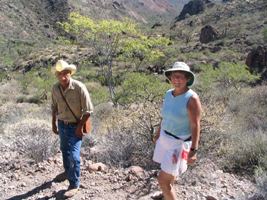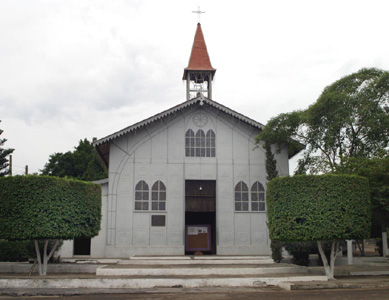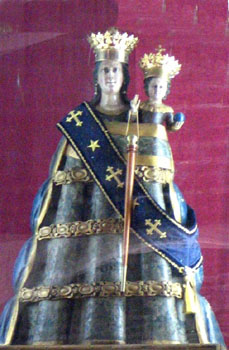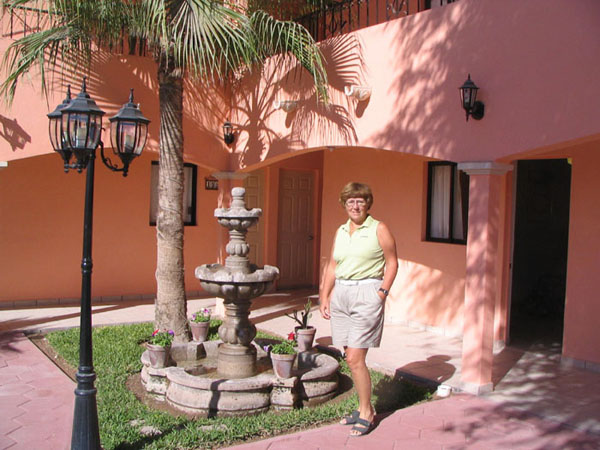We stopped briefly at Guerrero Negro, winter home to the gray whales and one of the largest salt extraction facilities in the world. They have 300 sq miles of pools where they evaporate the water off and scrape up the salt – about 6 million tons a year. Unfortunately, the gray whales don’t arrive until December and, as it was Sunday, the salt facilities were closed. We did manage to see some of the salt at the edge of a pool.
We continued another 150 km before stopping for the night at San Ignacio. Just out of Guerrer Negro, we passed the marker for the half-way point on the transpenninsular highway so have only about 850 km to go.

Monday, we went to visit the rock art site. This one is bigger than the one at Cataviña and required both a permit and a guide. We got the permit in town, then headed to the site. It was 20 km down the highway and an hour on a primitive road (air out of the tires again) following a sketch map drawn for us at the permit office. After some anxiety over whether we had missed it, suddenly, there was the guide standing in the middle of the road waiting for us. He wasn't a guide in the sense of telling us about the art - his job was to show us the way and make sure we didn't damage anything. He took us on a 1 ¼ hour hike up the mountain to the art site where there was a mural painted in an overhang type cave. It was about 150 ft (50 m) wide and 40 ft (13 m) high. Then we retraced our route back to the highway and continued on.
The highway arrives at the Sea of Cortez at the town of Santa Rosalia, built by El Boleo, a French mining company for a copper mining and smelting operation which closed in 1985. Today, it is best known for a church which was designed by Eiffel and was first displayed at the 1889 Paris World Fair alongside Eiffel's Tower. The church was an experiment in pre-fab using galvanized iron and was intended for French colonies in Africa. It was bought by a Boleo official and brought to Santa Rosalia.
The area wasn't particularly attractive so we continued another hour south to Mulege (Moo-leh-HEH), a small beach town on the Sea of Cortes. There, we camped for two nights with the day between spent resting, doing laundry, reading on a beach at nearby Bahia Concepcion and repacking the car.

Eiffel's Church in Santa Rosalia

After all the narrow roads, it never occurred to us that we were now in a big city with divided roads. We were going out to the golf course when Allen got a ticket for going the wrong way on a one-way street. He had followed the sign to the golf course and turned left at the T to come face to face with a policia van. The officer said that it was obvious that Allen should have gone to the right and around the circle which would put us on the other side of the divided road. He said the fine was 400 pesos. After arguing for half an hour, Allen gave him 200 pesos and we were on our way again. It was our first brush with the law in ten years of visiting and driving in Mexico.
After all that, when we got to the golf course, we decided it was too hot to golf so we continued south again.
The Home Stretch
Leaving Loreto, we pressed on, back across the peninsula to the Pacific side, stopping for the night in Ciudad Constitucion (Constitution City). There we stayed in a $35 hotel that was as good as the $75-100 ones we had been in to date. Ciudad Constitucion is another agricultural area with irrigation water coming from aquifers deep underground and piped everywhere. It is also another winter home of great numbers of gray whales. It is only about 5 hours north of San Jose so we decided to leave sightseeing there for another time.
In the morning, we headed south, crossing the peninsula again to La Paz, the capital of Baja California Sur. We stopped there for a picnic lunch on the Malecon, the downtown street along the ocean. And then the final 2 1/2 hours to San Jose.
